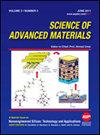Influence of Oxygen Adsorption on Local N-Doped TiO2/p-Si (100) Heterojunction UV-Visible Photodetector
IF 0.9
4区 材料科学
引用次数: 0
Abstract
TiO2-based devices are known for their responsive behavior to environmental conditions. In this study, we report the fabrication of a locally N-doped TiO2/p-Si (100) heterojunction UV-vis photodetector, achieved through a series of processes including magnetron sputtering, high-temperature annealing, hydrothermal synthesis, and thermal evaporation. Due to surface oxygen adsorption and partial nitrogen doping in TiO2, the photocurrent of the device was found to be higher in vacuum than in air at low voltage, and lower in vacuum than in air at higher voltage. Moreover, the photocurrent was more likely to reach saturation under vacuum at low voltage. Under UV light illumination (380 nm), the voltage applied to the device to reach the saturation currents in vacuum and air were approximately −1 V and −1.5 V, respectively, and these values increased slightly when illuminated by visible light (480 nm). The study of the impact of oxygen adsorption and partial N doping in TiO2 on the hindrance and multiplier effects of carrier movement in photodetectors can be beneficial for the development and application of wearable, biosensing, and vacuum sensing devices.氧吸附对局部n掺杂TiO2/p-Si(100)异质结紫外-可见光探测器的影响
基于TiO2的器件以其对环境条件的响应行为而闻名。在本研究中,我们报道了通过磁控溅射、高温退火、水热合成和热蒸发等一系列工艺制备的局部N掺杂TiO2/p-Si(100)异质结UV-vis光电探测器。由于TiO2中的表面氧吸附和部分氮掺杂,发现该器件在真空中的光电流在低电压下比在空气中高,在真空中比在高电压下在空气中低。此外,在低电压下,光电流更有可能在真空下达到饱和。在紫外光照射(380 nm)下,施加在器件上以在真空和空气中达到饱和电流的电压分别约为−1 V和−1.5 V,当被可见光照射(480 nm)时,这些值略有增加。研究TiO2中的氧吸附和部分N掺杂对光电探测器中载流子运动的阻碍和倍增效应的影响,有利于可穿戴、生物传感和真空传感器件的开发和应用。
本文章由计算机程序翻译,如有差异,请以英文原文为准。
求助全文
约1分钟内获得全文
求助全文
来源期刊

Science of Advanced Materials
NANOSCIENCE & NANOTECHNOLOGY-MATERIALS SCIENCE, MULTIDISCIPLINARY
自引率
11.10%
发文量
98
审稿时长
4.4 months
 求助内容:
求助内容: 应助结果提醒方式:
应助结果提醒方式:


